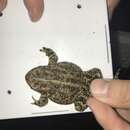en
names in breadcrumbs


Throughout the 1950s the Houston toad's populations declined sharply. Regional drought was the largest contributor to this, followed by loss of suitable habitat due to land development. Soil erosion, cattle grazing, and pesticide run-off have all limited the number of suitable breeding ponds. Conservation efforts have attempted to counter habitat loss. Most notably have been two land purchases in the 1970s. In 1971 the University of Texas Environmental Science Department purchased 1400 acres of forested land adjacent to Bastrop State Park to use as a study area. In 1979 the Texas Parks and Wildlife Department purchased another 717 acres. In 1974 the Houston toad was listed as an Endangered Species, and a recovery plan was created. Its goal is the removal of A. houstonensis from the endangered species list through habitat expansion and enhancement.
US Federal List: endangered
CITES: no special status
IUCN Red List of Threatened Species: endangered
Development - Life Cycle: metamorphosis
Besides the aesthetics of the Houston toad's bell-like calls (perhaps appreciated only by enthusiasts), it has little economic value to humans. Although Houston toads do limit insect populations, other more abundant sympatric toad species also fulfill this role.
Tadpoles feed primarily on pollen (usually from nearby pines), the jelly envelopes of other recently hatched Houston toads, and algae on floating leaves. Adults feed primarily on ground beetles, although they have been known to eat smaller toads and ants. They utilize two methods to capture prey: sit-and-wait and active search. For the sit-and-wait method, A. houstonensis first digs a small depression in the soil with its powerful hind legs. The toad then rests in the depression and scans the surrounding area for movement. When prey is detected B. Houstonensis leaps forwards and takes the prey into its mouth. Depressions are abandoned many times per day and new ones dug nearby.
The Houston toad is limited to an extremely small range in southeastern Texas. Since its discovery in 1953 it has never been found north of Burleson County, south of Fort Bend County, east of Liberty County, or west of Bastrop County.
Biogeographic Regions: nearctic (Native )
Tadpoles are found in non-flowing pools that last for at least 60 days. Adults are restricted to sandy soils and prefer wooded areas interspersed with open grass. They are also found in coastal prairies. Within these habitats they are never far from water, and during the breeding season are located almost exclusively near ponds and rain pools.
Terrestrial Biomes: savanna or grassland ; forest
The upper part of Houston toads is usually light brown in color, though it may sometimes be reddish. It possesses a variable number of dark brown or black spots. The underbelly is cream colored and usually very mottled. There is always at least one brown spot on the pectoral region. Females are 52-80 mm long (snout to vent). Males are smaller, being 45-70 mm long. Tadpoles are 13.7-22 mm long. Tadpole bodies and the upper 75% of their tails are heavily pigmented.
Other Physical Features: ectothermic ; bilateral symmetry
Breeding occurs between the end of January and the end of June, but peaks in late February. Early breeding often begins when the prior 24-hour period's temperature has not fallen below 14 degrees C. Mating occurs at night near shallow pools of water or ponds. Males begin their mating calls twenty minutes before sunset while still in their burrows. After ten minutes they begin moving toward a breeding pond, arriving between sunset and midnight. Once there, they seek elevated places from which to call. This call consists of a long high pitched trill. The first females begin arriving several hours after sunset. Once a female has selected a mate, the male remains clasped to the female for at least six hours. Between 500 and 6000 eggs are laid and fertilized in the water during the early morning hours. Afterwards males issue a release call consisting of a short barely audible release vibration, and an even shorter release chirp. Eggs hatch in seven days and metamorphosis begins in 60-65 days. Males reach sexual maturity in 1 year, and females at 1-2 years. Males typically breed for 2 seasons; females, for at least as long.
Key Reproductive Features: gonochoric/gonochoristic/dioecious (sexes separate)